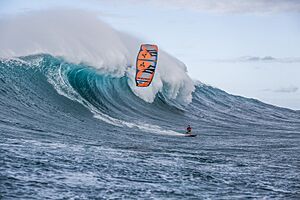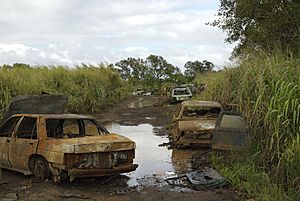Peahi, Hawaii facts for kids
Peʻahi (pronounced pay-AH-hee) is a special place on the north shore of Maui, an island in Hawaii. It's famous for its giant waves, which are also known as Jaws. This spot is one of the most exciting places in the world for big wave surfing.
Contents
Where is Jaws Located?
The Jaws surf break is about three miles east of Pāʻia. It's on the ocean side of the Hana Highway. The waves break a few hundred feet from the tall cliffs on the north shore.
The best way to see the waves when they are breaking is from the Pe'ahi Overlook. This spot is at the end of Hahana Road. This road is mostly unpaved and can be tricky to drive, especially when it's wet. If you don't have a 4-wheel drive vehicle, it's about a 1.5-mile walk.
There are no sandy beaches right near Jaws. You watch the waves from the top of cliffs that are 100 to 150 feet high.
Why is it Called Jaws?
The name Peʻahi originally came from an ancient Hawaii land area. This area stretched from the slopes of Haleakalā mountain down to the sea.
In the Hawaiian language, Peʻahi means "wave" in the sense of a fanning or beckoning motion of the hand. The name "Jaws" for the surf break is a fun play on words. In 1975, three Maui surfers – John Roberson, John Lemus, and John Potterick – were surfing there. The waves suddenly became huge and dangerous. They nicknamed the spot "Jaws" after the movie Jaws, because the waves were as unpredictable as a shark attack!
How Surfers Ride Jaws
In the 1980s, some brave windsurfers like Mark Pedersen, Dave Kalama, and Brett Lickle started riding the waves at Jaws.
The waves at Jaws can get super big, sometimes over 60 feet tall! This usually happens between December and March. Such huge waves attract famous big wave surfers like Laird Hamilton and Dave Kalama. They often use a method called tow-in surfing. This is where a personal water craft (like a jet ski) pulls the surfer into the wave. This method was co-invented by them along with Darrick Doerner and Buzzy Kerbox.
Surfers often use jet skis to get to the waves. This helps them avoid a tough climb, rocky beach, and the fast-moving waves. They launch from nearby places like Māliko Bay.
Scientists have studied the extreme size of these waves. They found that an underwater ridge helps create these massive swells.
The popularity of Jaws grew a lot after it was featured in a few places:
- In 1997, Charles and Leslie Lyon published a book of surfer photos called Jaws Maui.
- An article about Jaws appeared in National Geographic magazine in November 1998.
- In 2001, Doerner, Kalama, and Hamilton were stunt doubles for James Bond in the movie Die Another Day. The opening scene was filmed at Jaws!
- National Geographic Adventure magazine also had an article in July 2002.
All this attention made the spot very popular, sometimes leading to too many people by 2004. The best places for people to watch are the lookouts on the cliffs above the waves. Professional photographers often use boats or helicopters to get the best shots.
There have been several "World Cup of Tow-in Surfing" contests held at Jaws. However, the dates can't be set too far in advance because the wave conditions change a lot. The Billabong XXL awards, which celebrate big wave surfers, often have nominees from Jaws for the "biggest wave" category. Even very experienced surfers can get seriously hurt on these powerful waves. Because the location is remote, rescues often need expensive helicopters.
Paddle-in Surfing at Jaws
For a long time, surfers used jet skis to catch the giant waves at Jaws. But then, a new challenge began: paddle-in surfing. This means surfers use only their own arm power to paddle into these huge waves, without any help from a jet ski.
In 2001, Chris Bertish from South Africa was the first to paddle into a giant wave at Pe'ahi. This showed everyone that it was possible!
The "Mad Dogs"
In 2006, three surfers from Brazil – Danilo Couto, Marcio Freire, and Yuri Soledade – moved to Hawaii to ride the world's biggest waves. They became known as the "Mad Dogs." They started paddle-surfing Jaws without jet ski support, rescue teams, or life jackets.
- Danilo Couto became famous as one of the best big wave riders.
- Marcio Freire was a champion surfer in Brazil.
- Yuri Soledade is a successful businessman who loves chasing big waves.
A documentary called "Mad Dogs" tells their story and shares their experiences surfing at Jaws. On March 14, 2007, the "Mad Dogs" showed that paddle-surfing Jaws on a big wave day was truly possible.
More Paddle-in Achievements
On January 4, 2012, many of the world's best big wave surfers came to Hawaii for an amazing day of surfing. Jeff Rowley from Australia made history that day. He was the first Australian to paddle into a wave over 50 feet tall at Jaws! He did this as part of his "Charge for Charity" mission to raise money for Breast Cancer Australia.
On January 30-31, 2012, Jeff Rowley and other international surfers spent two days paddle-surfing Jaws. This helped prove that paddle-in surfing was the new way to ride these deep-water reef waves. On March 30, 2012, Rowley was a finalist in the Billabong XXL Big Wave Awards for his rides at Jaws. He placed 4th in the world among elite big wave surfers, earning a lot of respect.
Red Bull Jaws Contest
A big wave surfing contest called the Red Bull Jaws Peahi Challenge has been held at Jaws. It invites about 21 of the best big wave surfers from around the world. The waiting period for the contest usually runs from December to March, as they wait for the perfect big waves. Some famous surfers invited to this contest have included Jeff Rowley, Albee Layer, Greg Long, Shane Dorian, John John Florence, and Kala Alexander.



